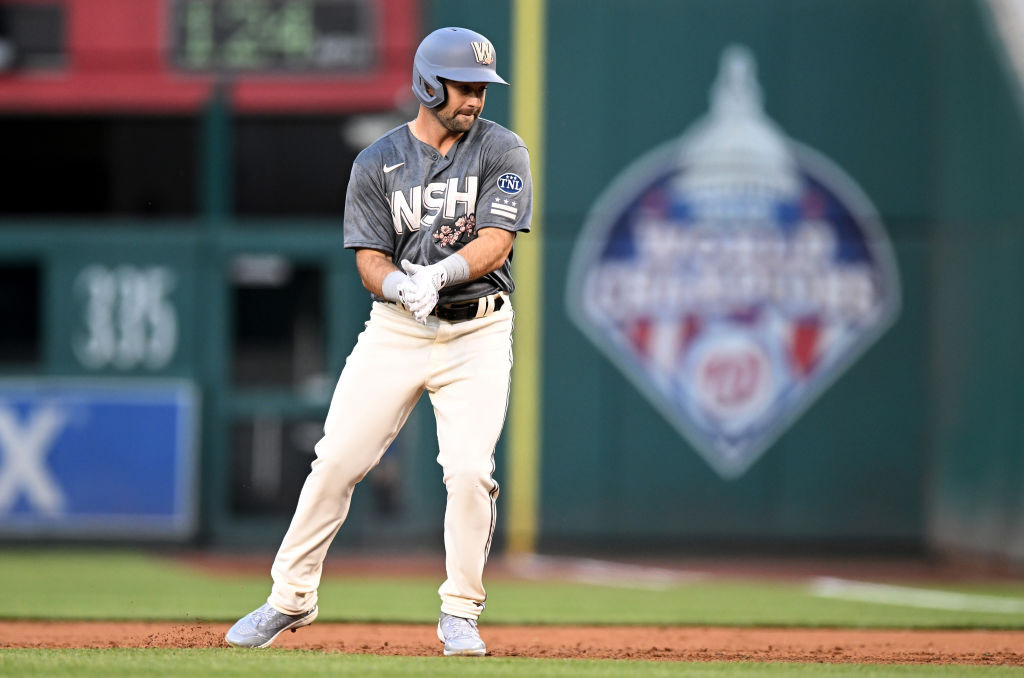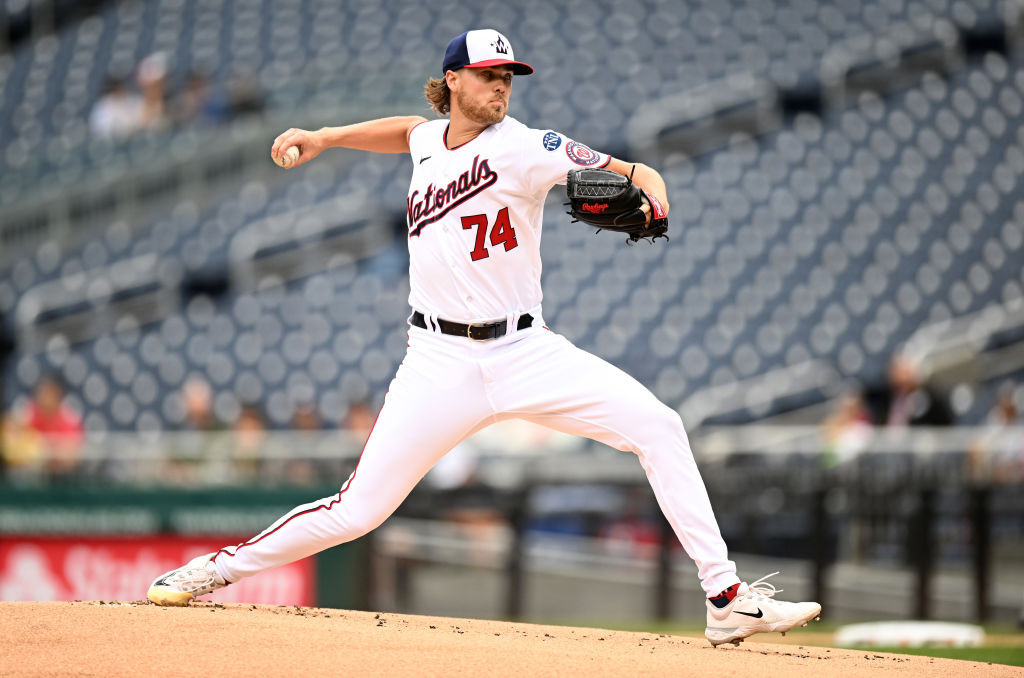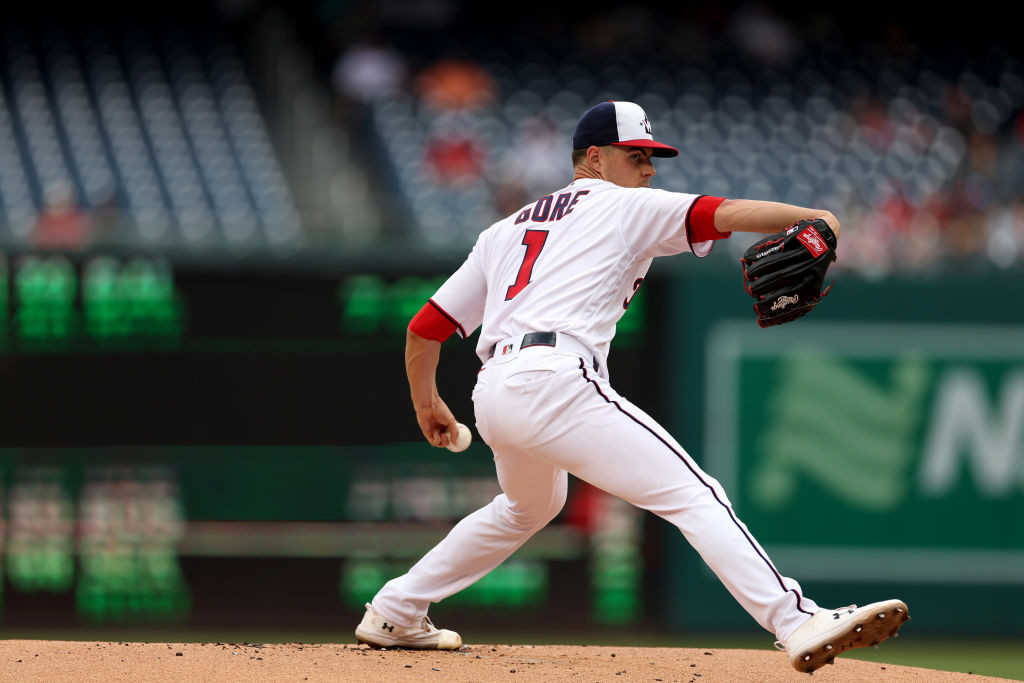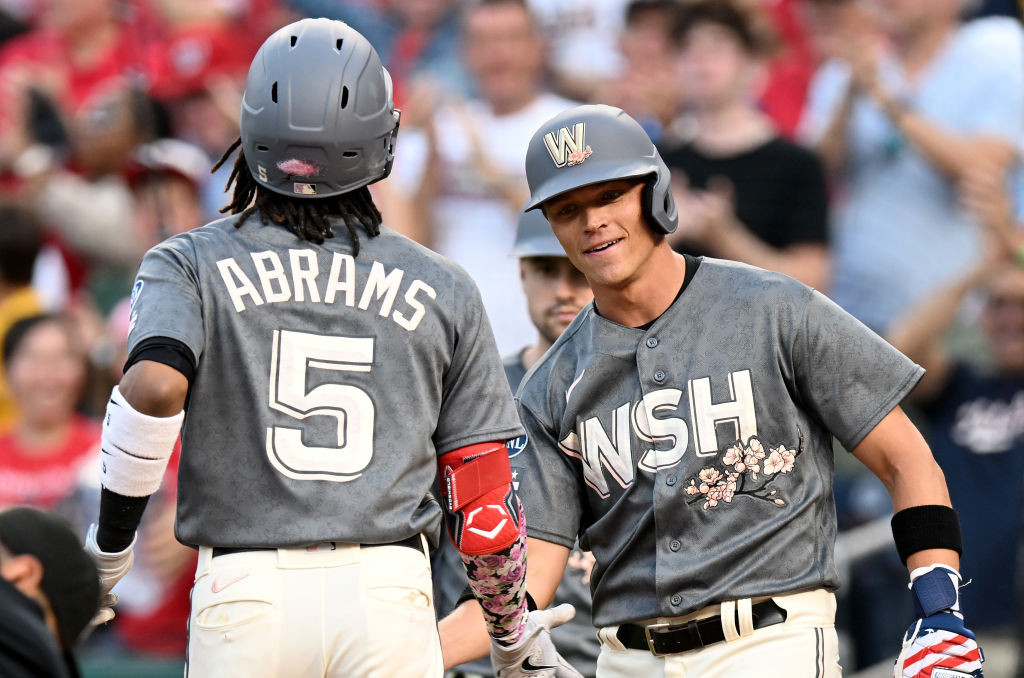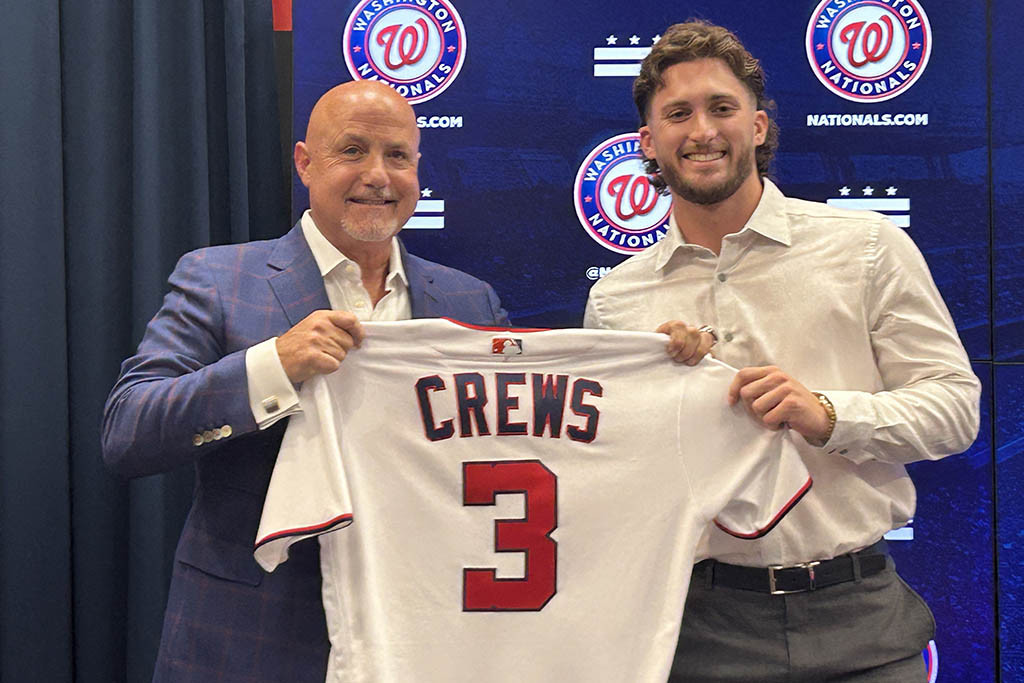PHILADELPHIA – While yesterday’s rainout helped the Nationals’ exhausted, yet effective bullpen, one still wondered how it would affect the red-hot offense, which averaged just over six runs per game against the Reds over the weekend.
Early in Game 1 of this doubleheader, it seemed to have no effect. But after the Nats jumped out to an early lead thanks to a couple of home runs, the Phillies daunting lineup responded with a homer barrage of their own. And when it was all said and done, this home run derby left the Nationals with an 8-4 loss.
“I was able to get all my work in when I needed to," said Nationals starter Trevor Williams after making his first start in nine days. "As far as the results today, we took a loss. There are some positives to look at through there. You eliminate the longball and it's a different ballgame."
The early lead came off the bats of Keibert Ruiz and the new 1-2 punch atop the Nats lineup.
Ruiz turned on a high fastball from Phillies starter Zack Wheeler and sent it 99 mph out to right field, hitting the scoreboard hanging over the stands 390 feet away. The catcher’s 12th homer of the season gave the Nats a 1-0 lead in the second.
PHILADELPHIA – While this four-game series between the Nationals and Phillies actually gets underway this afternoon, let’s revisit some injury updates from manager Davey Martinez that he gave prior to yesterday's rainout.
The Nationals have seven relievers currently on the 15-day injured list, with a handful of them making significant strides toward returning soon.
Carl Edwards Jr., on the IL with right shoulder inflammation, is getting close to a rehab assignment with a minor league affiliate after throwing bullpen sessions and working toward a simulated game. If he clears those next two sessions while at the Nats’ facility in West Palm Beach, a rehab assignment would come next.
“Carl Edwards is continuing the throwing program,” Martinez said yesterday. “He'll throw a bullpen again tomorrow. If everything goes well, he's set to throw the sim game and then hopefully that goes well. And if everything goes well with that, we'll probably send him out on a rehab assignment. So progression, very good.”
Hunter Harvey, who is with the team in Philly while rehabbing his right elbow strain, was scheduled to throw another bullpen session today. If the Nats get a good report back from that, he too will head out on a rehab assignment soon.
PHILADELPHIA – Let’s try this again, shall we?
The heavy rain is gone, but the strong winds that came through Philly last night are still here. Regardless, the weather is much more suitable for not just one, but two baseball games today.
The Nationals are sticking with Monday’s scheduled starter Trevor Williams for Game 1 of the doubleheader. The right-hander should be plenty rested after throwing 89 pitches in just four innings in his last start against the Mets. The only concern may be if there’s any rust as that outing was nine days ago.
Meanwhile, the Phillies are saving Ranger Suárez for the nightcap while Zack Wheeler, their originally scheduled starter for Tuesday, gets bumped up to the first game. Wheeler is 8-5 with a 3.71 ERA and 1.107 WHIP in 22 starts. He has pitched to an impressive 2.36 ERA over his first four starts of the second half, though he has given up 11 runs in 8 ⅔ innings (11.42 ERA) in two starts against the Nats this year.
WASHINGTON NATIONALS at PHILADELPHIA PHILLIES
Where: Citizens Bank Park
Gametime: 4:05 p.m. EDT
TV: MASN2, MLB.tv
Radio: 106.7 The Fan, MLB.com
Weather: Partly cloudy, 78 degrees, wind 14 mph in from left field
NATIONALS
SS CJ Abrams
RF Lane Thomas
DH Joey Meneses
1B Dominic Smith
C Keibert Ruiz
2B Jake Alu
3B Ildemaro Vargas
LF Blake Rutherford
CF Alex Call
PHILADELPHIA – Rainouts and doubleheaders are usually bad news for pitchers. A pregame or warmup routine can be thrown off if the game isn’t called until too close to the first pitch. And 18 innings, with the potential for more, are a lot to cover in a single day.
But for the Nationals, last night’s rainout and today’s doubleheader against the Phillies might actually benefit their pitching staff.
Despite a plethora of injuries, the Nats bullpen has been one of the best in baseball in recent weeks. The Nats currently have seven relievers on the injured list, with the latest casualty being Mason Thompson landing on the 15-day IL with a left knee contusion.
But over their last 16 games, the Nats bullpen has posted a collective 2.39 ERA, the best in the National League and third-best in the majors during that span. Relievers have also posted a 1.139 WHIP and 8.5 strikeouts per nine innings over 52 ⅔ innings since July 21.
“I think we're starting to realize that we need to attack the strike zone and get ahead,” manager Davey Martinez said during his pregame press conference before yesterday’s postponement. “That's been the biggest difference right now for our bullpen guys is that we're really emphasizing getting ahead of hitters, attacking them early and not put yourself in a hole. And these guys have done that, and they've done really well.”
PHILADELPHIA – Like many thought throughout the day, there will be no baseball played at Citizens Bank Park tonight.
The Nationals and Phillies have been postponed due to the approaching storms in the Philadelphia region, which have been going up the entire East Coast this afternoon. The game will be made up tomorrow, Aug. 8, at 4:05 p.m. as part of a single-admission doubleheader. Game 2 will start approximately 30 minutes after the conclusion of Game 1. Both games will air on MASN2.
If you are planning to attend tomorrow’s game, all gates will open at 3:05 p.m. Tickets from tonight’s game will not be valid for either game on Tuesday.
Trevor Williams, who was scheduled to start tonight, will start Game 1 tomorrow, with Josiah Gray starting Game 2.
The rotation will actually be OK moving forward despite the upcoming doubleheader. The Nats have off-days on each of the next two Mondays. And with Joan Adon’s successful start on Saturday and Williams’ return from the bereavement list, they have six starters readily available for the near future.
PHILADELPHIA – Hello from Citizens Bank Park for the start of what has turned into a highly anticipated four-game series between the Nationals and Phillies.
The Nats are coming off an impressive three-game sweep in Cincinnati and are now owners of an 11-5 record since July 21. The Phillies just won two of three against the last-place Royals and have won five of their last seven games while tied with the Giants for the first National League wild card spot.
Tonight’s pitching matchup is a rematch of the July 2 game here when the Nationals sealed a series win in Philly: Trevor Willams vs. Ranger Suárez.
Williams, who was officially activated off the bereavement list yesterday, has had a bit of an odd schedule so far this second half. He’s only pitched 17 ⅔ innings over his four starts since the break, limited to just 2 ⅔ in St. Louis because of rain and only lasting four in his last start on June 30 in New York before going on bereavement leave. He did complete five innings while giving up three runs and earning the win here last month.
On the other side, Suárez has been able to eat up a little more innings for the Phillies, going at least five in each of his second-half starts. He only gave up one run over 6 ⅓ innings in his previous start against the Marlins, but the left-hander gave up five in 5 ⅓ when he faced the Nats in July.
Cole Henry has had a long road in front of him. Ever since he decided to undergo surgery for thoracic outlet syndrome last August, he has faced an uphill climb to get his career back on track.
All things considered, it’s been so far, so good for the Nationals’ No. 12 prospect, per MLB Pipeline.
Thoracic outlet syndrome surgery has a negative stigma surrounding it in baseball, especially here in Washington as it derailed the careers of Stephen Strasburg and Will Harris.
Granted, those pitchers were older than the now 24-year-old Henry was when they had their surgeries. But any procedure in which a rib and a neck muscle are removed would come with tales of caution.
But Henry is on the path to being a success story having been able to report to spring training just six months after his own surgery and pitching in minor league games three months after that.
The 6 p.m. trade deadline came and went without any more moves from the Nationals. The front offices on South Capitol Street remained quiet after yesterday’s deal that sent Jeimer Candelario to the Cubs for two prospects.
So it was back to business as usual for the boys in the navy blue jerseys and curly W caps.
“Play baseball after that," manager Davey Martinez said after letting out a long sigh when asked about his emotions once the deadline passed. "A couple of our players came in at 6:01 p.m. and asked, 'Am I still here?' I go, 'Yeah, you guys are good. You got traded to the Washington Nationals, so congratulations. Keep playing.'”
Although the fact they didn’t trade away any more players may be a sign that the Nats are closer to contention now than they were when they started this rebuilding project at this time two years ago, unfortunately tonight’s on-field result was similar to many around these parts since the 2019 World Series: A 6-4 loss to the Brewers in front of 19,847 fans who came out to Nats Park on a beautiful August night.
Josiah Gray, who was acquired at the 2021 deadline, started the night off strong, but lost his command as the game went on.
We are just minutes before the trade deadline, and although the Nationals have made a few roster moves this afternoon, none of them have been in the form of a trade like last night’s deal of Jeimer Candelario to the Cubs for two prospects.
This afternoon the Nats announced they recalled infielder Jake Alu from Triple-A Rochester to take Candelario’s spot on the active roster.
“I was excited,” Alu said back in the Nats clubhouse. “I kind of understood the scenario of everything. Like I said, I was playing baseball just one day at a time and kind of just staying focused as much as I could. That's kind of how I went about it.”
This marks Alu’s fourth major league stint this season. He has appeared in five games, going 3-for-14 (.214) with one walk and one stolen base with the Nats.
On the farm, Alu, 26, has been having another strong season. He's tied for first among Nationals farmhands with 22 doubles and ranks in the system in hits (third, 90), runs (fifth, 48), batting average (sixth, .293), OPS (seventh, .777), RBIs (tied for seventh, 43), slugging percentage (eighth, .420) extra-base hits (eighth, 28) and on-base percentage (10th, .357).
It’s Trade Deadline Day, which means people all around baseball will be glued to their phones, computers and TVs awaiting the big moves being made throughout the day up until the 6 p.m. deadline.
For the Nationals, that means keeping an eye on names like Lane Thomas and Kyle Finnegan after Jeimer Candelario was traded to the Cubs for two prospects last night. Jake Alu was officially recalled from Triple-A Rochester this afternoon to take Candelario’s roster spot.
Thomas is in tonight’s starting lineup … for now. Keep an eye out for any lineup changes leading up to the deadline.
A guy who we know isn’t going anywhere and was acquired two years ago at the deadline is tonight’s starter, Josiah Gray. The young right-hander is 7-8 with a 3.27 ERA and 1.411 WHIP over his first 21 starts this year. After a shaky start to the second half, Gray has pitched seven innings of one-run ball and six shutout innings in his last two outings.
Freddy Peralta makes the start for the Brewers, who could be busy today as they are in a tight battle with the Reds at the top of the National League Central. Peralta is 6-8 with a 4.46 ERA and 1.248 WHIP in 20 starts this season. In five games (three starts) against the Nats, the right-hander is 2-2 with a 7.29 ERA and 1.381 WHIP.
For eight innings of yesterday’s finale, it looked like the Nationals offense had run out of juice to mount another comeback.
But that’s why baseball plays nine innings.
After Lane Thomas’ one-out single in the third inning, the Nats sent the minimum to the plate over the next 5 ⅔ innings. The only baserunner over that stretch was Jeimer Candelario, who was hit by a pitch from Peter Lambert in the sixth and then out on a double play ball by Joey Meneses.
The Nats only had five baserunners after eight innings on three hits, a walk and the hit batter.
“The chasing,” manager Davey Martinez lamented after the game on the Nats’ lack of offense. “We gave away too many at-bats because we were chasing all day today. We play a game like we did last night, come back and play at 12 o'clock. I tell these guys that’s part of growing up right now is that you got to grind today. Today's a grind day for some of our young players and veteran guys. It's not gonna be easy. I know it's hot. But you gotta grind.”
Despite the long wait and two rain delays, the Nationals built some momentum at the end of last night’s game with Joey Meneses’ dramatic three-run home run in the eighth inning.
After a 10-6 loss to the Rockies on Monday, the Nats were hoping to ride the high from a 6-5 win last night (or more accurately, early this morning) into this afternoon’s finale.
Well, for most of the afternoon, it seemed like it hadn’t. Then all of a sudden, the scrappy Nats came right back for another late rally.
The Nationals came back from another three-run deficit to beat the Rockies 5-4 on CJ Abrams’ walk-off single in the ninth in front of 16,893 fans who attended Nats Park on a blistering hot Camp Day.
"We showed hard as a team," Abrams said after the dramatic win. "It’s never over til it’s over, so keep fighting until it is.”
The Nationals brought in some bullpen reinforcement ahead of this afternoon’s finale against the Rockies.
Andrés Machado had his contract selected from Triple-A Rochester, Amos Willingham was optioned down to Rochester and Victor Robles was transferred to the 60-day injured list.
After starting the season in Rochester, Machado, 30, posted an 8.47 ERA and 1.765 WHIP in 17 innings over 14 major league appearances this season. He was designated for assignment on June 5 when Jordan Weems was recalled.
The right-hander struggled with his command in his short time with Washington. He gave up 25 hits, six home runs, five walks, a balk and a wild pitch while only striking out 12.
With the Red Wings, he has a 4.08 ERA and 1.186 WHIP in 28 ⅔ innings over 24 outings.
Well, after last night’s dramatic, twice-rain-delayed, comeback back win, can the Nationals carry their momentum over to win this series against the Rockies and end this homestand on a positive note?
If they do, it would be their second series win in a row and sixth in their last nine.
Jake Irvin will look to follow up one of the best outings of his young career this afternoon. On Friday, he struck out a career-high nine Giants over 6 ⅔ innings while earning his third win of his rookie year. Manager Davey Martinez was impressed with the adjustments Irvin made throughout that start – throwing his changeup more – so that will be something to keep an eye on today.
The Rockies are starting right-hander Peter Lambert in this finale. The 26-year-old right-hander is 2-1 with a 5.49 ERA and 1.525 WHIP over 16 major league appearances this year (two starts). This will be his third start in a row, combining to pitch only eight scoreless innings with five hits, two walks and five strikeouts.
WASHINGTON NATIONALS vs. COLORADO ROCKIES
Where: Nationals Park
Gametime: 12:05 p.m. EDT
TV: MASN, MLB.tv
Radio: 106.7 The Fan, MLB.com
Weather: Sunny, 86 degrees, wind 4 mph out to left field
Dylan Crews will soon arrive at the Nationals’ spring training facility in West Palm Beach and start getting acclimated to his new organization. It will be a two-way street of him getting to know his new coaches and the coaches getting to know their new player.
Someone who already knows Crews well as a player and as a person is his college coach: LSU head coach Jay Johnson.
Johnson, who attended Crews’ introductory press conference on Saturday donning a purple sports coat, was beaming while talking about the second of his former players who went Nos. 1-2 overall in this year’s draft.
“I think it’s the combination (of) that's an elite player, that’s an elite person,” Johnson said of Crews to a group of gathered media members at the conclusion of the press conference. “I think if you stack up his three seasons of college performance, you’d be hard pressed to find anybody any better. But there’s this humility that he plays with, this edge that he plays with, this ability to lift everybody up and make everybody else around him better on top of these baseball tools that show up every single day to help his team win. I mean, it’s a truly special player. After not going number one, there was really no decision, probably, for Washington to select him.”
Johnson’s first head coaching job came in 2014 at the University of Nevada. After two seasons with the Wolfpack, he accepted the gig at the University of Arizona, where he coached for six seasons before leaving to become the head coach at LSU in 2021.
It was not a taboo word around the Nationals clubhouse. In fact, in talking to members of the team before today’s finale against the Giants, no one was really too concerned about it.
But it had to be noted how long it has been since the Nationals last swept a three-game series. You have to go back more than two years to June 14-16, 2021 against the Pirates for the last time they accomplished that feat. And per STATS, the Nats have not swept a series in their last 96 attempts, which is the longest streak of series without a sweep in major league history after passing the Philadelphia Athletics’ 89 straight series without a sweep between 1914-1917.
Alas, they finally did it, sweeping the Giants in three games this weekend with a 6-1 win this afternoon in front of 23,404 fans at Nats Park.
"This weekend we played like I thought we'd play throughout," said manager Davey Martinez after the game. "With a lot of energy, it was a lot of fun. It was a great weekend for us. So I was proud of the boys. You saw us go first to the third, you saw us turn double plays when we needed to, make some good plays, steal some bases, get big outs. Everybody was on point. So it was a fun weekend.”
As they did in each of the past two nights, the Nats jumped out to an early lead and didn’t look back, the new top of the lineup once again leading the charge.
Nationals fans are aware of it. It may even bother them a little. But doesn’t seem to have an effect on the players and coaching staff in the clubhouse.
The Nationals have not swept a three-game series since June 14-16, 2021 against the Pirates. They have not swept a series in their last 96 attempts, expanding the longest streak of series without a sweep in major league history after surpassing the 89 straight series without a sweep by the Philadelphia Athletics from 1914-1917, per STATS.
Today, they have a chance to sweep the Giants after winning the first two games by a combined score of 15-4. But for the Nats, it’s just another chance to win a ballgame.
“Nah,” manager Davey Martinez said when asked if the team thinks about their sweepless streak during his pregame meeting with the media. “Like I said, we try to be where our feet are. Try to go about our business, go 1-0 today. What I can tell you is these guys will come out today and they'll compete. They'll play hard. If everything aligns, we'll come out, we'll win and it's just another victory for us.”
Jake Irvin and Josiah Gray led the Nats to their first two victories this weekend, pitching a combined 13 ⅔ innings and allowing four runs.
Is today the day? Will it finally happen? Can this unfathomable streak be ended?
Once again, the Nationals are seeking their first three-game series sweep since June 14-16, 2021 against the Pirates. This will be the Nats’ fourth opportunity to sweep a three-game set this season.
They were able to win the first two games behind strong starting pitching from Jake Irvin and Josiah Gray, the young right-handers combining to allow four runs over 13 ⅔ innings against the Giants.
Now it’s MacKenzie Gore’s turn in his 20th start of the year. The 24-year-old lefty is 5-7 with a 4.59 ERA, 1.448 WHIP and 10.7 strikeouts-per-nine-innings. Gore was able to gut out 6 ⅓ innings in his last start against the Cubs, but he was charged with five runs, including two home runs. He didn’t face the Giants when the two teams met in San Francisco back in May. He did, however, go 1-1 while giving up nine runs in 9 ⅓ innings over two starts against them as a member of the Padres last year.
The Nationals offense will look to stay hot against Giants pitching, outscoring the visitors 15-4 over the first two games.
Today was one of those days where, in the grand scheme of things, the result of the Nationals’ game against the Giants didn’t really matter. The franchise introduced Dylan Crews, the No. 2 overall pick in this year’s draft, as one of the “keystone” pieces for the future.
Many were thinking about the next competitive Nationals team a few years down the line. But the players in the home clubhouse were not.
On the day the Nats celebrated Crews, they also celebrated a victory as they cruised to a 10-1 win over the Giants in front of 32,504 fans who came out to welcome the newest prospect and watch a ballgame.
And what a ballgame to watch if you were supporting the team wearing the cherry blossom uniforms, who won their second straight to take this series against the Giants.
"Yesterday was good, today was really good, so I like the trend," manager Davey Martinez said.
It was another monumental day for the Nationals franchise and its future.
After making the signing official, the organization officially introduced No. 2 overall pick Dylan Crews as its latest highly touted prospect.
“Another exciting day here at Nationals Park,” said general manager Mike Rizzo to begin the introductory press conference in front of members of the Lerner family, Crews family and local media. “Over the years that I've been here, we've been here many times and few occasions can match the excitement that we have today. To get into the organization one of the most decorated, accomplished, winning-type of players in collegiate history to join the Washington Nationals is a special occasion for us.
The Nationals made the LSU outfielder the No. 2 selection of the 2023 MLB Draft two weeks ago. Crews reportedly signed a deal worth $9 million, the highest ever given to a position player in the bonus slot era of the draft. His college teammate, Paul Skenes, set the overall record with a $9.2 million bonus as the Pirates’ No. 1 overall pick.
Jim Callis of MLB.com reported the final number.




-1745819772711.png)









